Introduction
Nowadays, the digital economy, being more developed than ever, is becoming a major pillar of the global economic activity as it manages facilitating the exchange of data at the micro and macro-economic levels. The exchange of data – in the context of the previous statement – refers to any type of binary transfer, which can fall under the umbrella of several fields of activity, such as medicine, technology, agriculture, etc. The digital economy can be perceived as a system that successfully interconnects and intraconnects economic sectors around the world. The data exchange achieved through intra-connection and inter-connection can be easily exemplified as follows: the implementation of economic modeling algorithms through economic management information systems, whose outputs impact the functions of production, procurement, accounting and finance of an organization; respectively making a purchase through digital channels.
The digital economy, as a matrix structural system, facilitates and, at the same time, fuels the transactions (data exchange) within the micro and macro-economic systems, having a decisive role in the economic and social development worldwide.
This article aims to conduct a bibliometric study on the digital economy, with the intention of determining, according to the academic and scientific research environment, not only the main roots of the digital economy, but also the directions of its strategic development. This will be performed through the analysis of the selected papers, citation report and keywords.
To carry out this study, 4,624 scientific papers published in journals or specialized conferences between 1979 and 2021 will be analyzed. The benchmark papers of this analysis are selected from Web of Science (WoS) database. Microsoft Excel and Vos Viewer programs will be used to process data from the database. The method of selecting and processing the database, which will be the basis of this bibliometric analysis, will be described in detail in the Research Methodology and Data Collection section. Prior to this section, a small Literature Review will be conducted in order to identify, through a qualitative analysis, the main springs of the digital economy. In other words, in the authors view, it is important to determine the “existence reason of the digital economy”.
Literature Review
The objective of a bibliometric review article is to evaluate and highlight the literature in a particular field (Andres, 2009; Yang et al., 2012), mapping information such as: areas of approach for certain fields; the main authors, the language in which it was written, the university and the country of origin. Moreover, a very important aspect in such a study is the analysis of keywords, by clustering and tracing the connections between them, thus showing the level of interconnection between certain topics/areas. The elements mentioned above answer questions such as “Who?”, “What?”, “How?”, “When?”, and “Where?”, representing all the aspects that must be addressed in a bibliometric review article (Polley, 2014). The bibliometric review study is based on a quantitative analysis, as the process of building it is based on precise, numerical data about the literature (Wu et al., 2016). Keywords analysis, being an important element in such a study, can highlight the research directions in the field (Musgrove et al., 2003), which, in turn, can be correlated with the development directions of that field.
The qualitative analysis of the sources of digital economy, the factors that contribute to its development, starts from the definition of the digital economy, which may include this information. Many of the definitions of the digital economy (Brynjolfsson & Kahin, 2000; DETF, 2016; van Gorp & Batura, 2015) refer to the added value, interconnectivity and economic transformation through digital technologies. The analysis of the three elements highlights not only the description of the process and the system (transformation through digital technologies; interconnectivity), but also its result, the added value, which has to be measured. In the government program “Digital Economy of the Russian Federation”, the digital economy is described as a system in which digital data is a key product in the production activity of all social and economic systems, in order to increase the competitiveness of systems (George et al., 2020) and the living standards, and to support economic growth. As previously stated, digital economy has the potential to impact many economic areas (Bradley, 2007). It offers many opportunities for both public and private sectors, as well as for the social life of the people. Opportunities are created through digital technologies, which are having the capability to integrate various processes and activities into the digital environment (Lock & Seele, 2017).
Research Methodology and Data Collection
As previously mentioned, the purpose of this bibliometric study is to highlight the imaging of the digital economy in the literature, and respectively of the scientific research environment. Thus, the article aims to perform a retrospective analysis of the digital economy, highlighting the main areas of approach, and the analysis of the evolution of the intensity of this topic from each area; the citation report, in order to highlight the most recognized writings; the main authors who contributed significantly, the institution and the country of origin; keyword analysis, by mapping the links between them according to the level of intensity and presenting the occurrence of each. Through this bibliometric review, it will be possible to identify the development trend of the specialized literature regarding the digital economy.
Data used for this study was obtained from the Web of Science Core Collection database, provided by Clarivate Analytics. The reason for choosing Web of Science is based on the quality and structure of easily accessible information in this database. The search was performed using the following keywords: “digital economy”; “Internet economy”; “New economy”; and “Web economy”. The selection of keywords is based on the synonymy between them, as the last three keywords used are alternatives to the concept of digital economy. The connection between the “internet economy” and the “digital economy” is reported in several scientific papers (Margherio et al., 1999; OECD, 2013; DBCDE, 2013; European Commission, 2013; British Computer Society, 2014; Dahlman et al., 2016; OUP, 2017; Deloitte, nd), the latter being defined through the former; thus, the internet is the basis of the digital economy, whose existence coagulates through the World Wide Web – the internet. The concept of “new economy” is a relative one, whose significance varies depending on the moment of definition. In the current century, the new economy refers to the digital economy (United Nations, 2017). Also, the novelty of the economy is outlined with the help of the latest technologies and innovations, which, in this context, are the subject of the digital economy – cloud computing, internet of things, data science, big data, etc.
The “or” connector between all keywords was used in the search body to include, in the list of results, any element associated with at least one of the keywords used. The condition of relevance of results requires that they are associated with at least one of the keywords used in the search, as they are considered to be synonymous. Each keyword in the search has been isolated in quotation marks to get results associated exclusively with the meaning of the keywords used. Failure to use quotation marks would have automatically placed the “and” connector between keywords that do not have a connector at the time of the search, reducing the volume of results. The search was performed based on the topic, increasing the search spectrum of keywords used in the title, abstract, keywords used by authors and keywords indexed by the database. Using this search criterion involved extending the number of results, avoiding detailed filtering. Also, the search did not impose restrictions on the period in which the writings were published, as the number of results for the first five years (1997 – 2001) contributes with a percentage of 8.44% to the number of results, being relatively low, taking into account that this time interval represents 20% of the entire analyzed period. In fact, taking into account the first years in which there were publications in this field can be beneficial for the bibliometric analysis, as it will bring to the attention of authors and readers the reference fields in which the first writings appeared regarding the digital economy, and how their contribution has evolved in percentages over the entire period.
The search in the WoS database, which took place on 10 February 2021, resulted in a number of 5,414 scientific papers, which were filtered by the type of document, with articles published in journals and conferences being selected, resulting in 4,624 scientific papers, which will be analyzed in the next section. Out of these 4,624 selected papers, 2,790 are articles published in Journals and the rest, 1834, are proceedings papers. The analysis will be performed through Excel Microsoft Office (Version launched in 2016) and Vos Viewer (version 1.6.16). The data will be presented in tabular and graphical form. Also, in the analysis, the functions of “Results Analysis” and “Citation Report” provided by the Clarivate Analytics platform will be used. To reflect the quality of this research, the selected papers are included in the next databases of WoS Core Collection: SCI-Expanded (490 papers), SSCI (1363 papers), ESCI (925 papers), CCR-Expanded, IC, CPCI-S, CPCI-SSH, BKCI-S, BKCI-SSH. All databases indexation was included in this research to be able to reflect a relevant result, considering that WoS has important and concrete selection criteria.
Data Analysis and Discussions
Analysis of selected papers
This section of the paper begins by analyzing the selected scientific papers, according to the criteria described in the previous section, followed by the analysis of citations and keywords, and the links formed between them. Thus, the analysis covers 4,624 articles published either in journals or in conferences.
Figure 1: Evolution of published papers per year
(Unit of measure: absolute number of papers)
Source: Authors’ own computation through Excel software, with data extracted from WoS (2020)
Figure 1 shows the evolution of the number of articles published in journals or conferences, during 1979-2021. It is noted that the evolution of this indicator has had a significant increase in the last years analyzed, with the period 2016-2020 having over 55% of the total number of scientific papers.
The preliminary analysis of Figure 1 highlights an area whose approach can be said to be mature and which has had an explosion in terms of the associated interest. Digitization has grown in the last five years in the analyzed period, with increasing investments and interest in this field. In 2020, there might have been a sharp decline in the number of scientific papers, which could be due to the Covid-19 pandemic, as the level of publications at conferences has dropped significantly, because they could no longer take place.
Despite the organization of conferences in the online, digital environment, the ratio of the number of scientific papers published at conferences to the total papers decreased from 46% and 50% in 2018 and 2019, respectively, to 14% in 2020. Also, another assumption on the decrease of the number of researches published in the conferences can be the shift of research directions to topics related to the pandemic, fields associated with medicine, biology, virology, etc.
Table 1: Allotment of papers per Top 10 origins: country/region
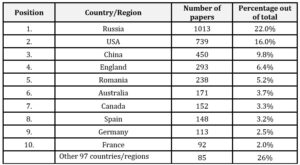
Source: Authors’ own computation with data extracted from WoS (2020)
Table 1 shows the distribution of the number of items by countries/regions. It is noted that most articles were published in Russia, contributing with a percentage of 22% to the total number. The next regions/countries are USA, China, England and Romania, with a contribution of 37.4% to the total number. Romania’s position is an important one in this ranking, occupying the 5th place after the previously mentioned countries. The distribution by country is not a balanced one, as the first five positions of the ranking have dominant positions, contributing with 60% to the total number of articles. Being the subject of future research, in the view of the authors, it would be at least interesting to analyze whether there is a correlation between the number of scientific papers recorded in a particular country/region and the level of development of the digital economy.
Table 2 : Allotment of papers per Top 10 universities/institutions
Source: Authors’ own computation with data extracted from WoS (2020)
Table number 2 shows the ranking of the top 10 institutions with the highest contribution in the scientific academic environment, by looking at the origin of the authors. It is noted that the dominant position of Russia on the top of the regions/countries with the highest contribution in the literature is visible in the table above, as 6 of the top 10 institutions are of Russian origin. Also, in the third position of the ranking is the Bucharest University of Economic Studies, which justifies Romania’s position in the ranking presented in table no. 1. Other universities are of American, British and Ukrainian origins, which is consistent with the data in the table above.
Table 3 shows the distribution of papers by research areas. The research field with the highest contribution is “Business economics”, integrating papers associated with business, economics and management. This field has a contribution of 42.2% to the total number of publications. The following fields with a considerable contribution are Computer Science, Engineering, Educational research and Governmental law. The order of the research areas, in the authors’ perspective, is not a random one; it is rather the result of an involuntary collective reasoning. The first field, being the object of the economic, business and management side, defines and establishes the basic motive of the digital economy, namely, the reason why it exists.
Table 3: Allotment of papers per Top 10 research areas
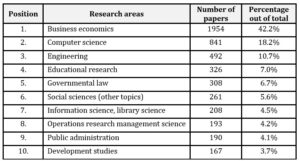
Source: Authors’ own computation with data extracted from WoS (2020)
The next three areas in the ranking can be considered as supporting areas that facilitate the existence of the digital economy, as technology fuels its development. The next field of research may be the field that regulates and governs the proper functioning of the digital economy in relation to the other supporting functions of an economic system.
Figure number 2 shows the evolution of the number of publications in each field of research in the analyzed period, 1979-2020. This figure highlights the consistency of the entries number for each domain. It is noted that the first domains presented in table no. 3 maintain their upward trend, while most of them reach the threshold of zero publications per year. The evolution of the publications number per field per year is influenced by both objective factors – economic phenomena associated with a particular period and other state variables that define the attractiveness of a particular area of the digital economy, as well as subjective ones- related to the choice of each researcher and his/her internal motivation.
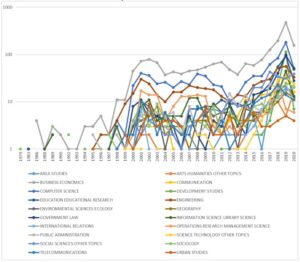
Figure 2: Evolution of published papers per research area per year
(Unit of measure: absolute number of papers)
Source: Authors’ own computation through Excel software, with data extracted from WoS (2020)
In table no. 4, the journals with the highest contribution of publications in the literature are presented. Most of the Journals presented in the table below are having economic origins.
Table 4: Top 10 Journals in terms of the biggest number of published papers
 Source: Authors’ own computation with data extracted from WoS (2020)
Source: Authors’ own computation with data extracted from WoS (2020)
Analysis of citations
The sequence of this bibliometric review involves the analysis of the citations made, according to the database extracted from WoS Core Collection. Figure no. 4 presents the evolution of the citations number in the analyzed period, 1990-2021. It can be seen that there is a sustained and continuous increase in the number of citations, which validates and consolidates the particularly high interest in this field, which is highlighted, at the same time, by the major increase in the number of articles published. It is also worth mentioning that the trend presented in figure number 4 highlights not only the interest associated with the field, but also the quality of publications.
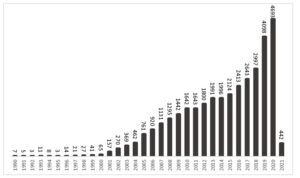
Figure 4: Evolution of the number of citations per year
(Unit of measure: absolute number of papers)
Source: Authors’ own computation through Excel software, with data extracted from WoS (2020)
Table no. 5 presents the top 10 most cited papers written. The first article, with 1178 citation, is published by Teece (1998) and deals with the subject of the new economy, the importance of know-how and the intangible assets of the organization. The article is published in the California Management Review. The second most cited article is published by Noorgard in 2010 with 551 citations. The rest of the articles in table no. 5 are from 2006 or older.
Table 5: Top 10 cited articles
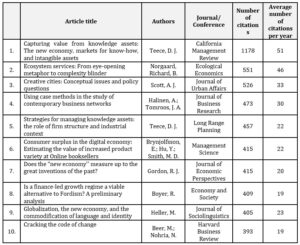 Source: Authors’ own computation with data extracted from WoS (2020)
Source: Authors’ own computation with data extracted from WoS (2020)
Analysis of keywords
The last component of this analysis involves conducting an examination of the keywords associated with the 4,624 articles selected for this study. The keywords used in this analysis include the ones written by the authors and also the ones that are automatically identified by the WoS Core Collection database system, in terms of associated functions. These words are extracted either from the title, abstract or content of the paper, and are based on a rigorous selection algorithm, which analyzes the frequency of words and their association with other high-resonant keywords. Keyword analysis was performed using VOSViewer software, version 1.6.16 (van Eck and Waltman, 2013), which is specifically designed to perform dynamic keyword analysis.
Conducting a keyword investigation involves addressing several directions: identifying and measuring the frequency of keywords in the articles included in the database (occurrence); measuring the links between keywords; analyzing the co-occurrences; and mapping the links between keywords formed over time.
The introduction of the article database in the VOSviewer program resulted in the identification of 11,910 keywords related to the subject of digital economy and other synonyms used in the search described a priori. As the number of resulted keywords is very high and their analysis would be extremely difficult, they were filtered based on their occurrence, thus choosing the most relevant keywords. The occurrence chosen to be used is 40. This means that each resulting keyword should appear at least in 40 articles. Thus, 52 results were identified, out of which, 10 with the highest frequency of occurrence are presented in Table no. 6.
Table 6: Links, occurrences and co-occurrences of the Top 10 keywords

Source: Authors’ own computation through VOSviewer
The resulting 52 words are transposed in Figure no. 5, in which the clustering of the keywords according to the group of affiliation is visible. At the basis of groups’ definition, the co-occurrences and the links between the keywords are used (van Eck & Waltman, 2013).
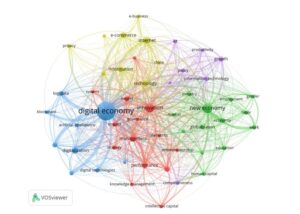
Figure 5: Map of keywords
Source: Authors’ own computation through VOSviewer
Nodes are representing the keywords resulting from co-occurring filtering. Thus, in the figure above, there are 52 nodes, whose clustering is visible through the colors in the figure. In graph no. 5, it is observed that certain keywords form a link that is wider than others. This is the strength of the link, which is given by the co-occurrence. For example, it can be seen that “digital economy” is found in most of the publications in association with “digitalization”, “digital technologies”, “industry 4.0”, “internet”, “innovation”, “big data” and “E-commerce”. From the analysis of the keywords and the links they form between them, the following can be stated: the digital economy is closely related to the innovation of digital technologies, with the associated technologies of Industry 4.0 (blockchain, artificial intelligence, big data, etc.). In connection with the definitions of the digital economy stated a priori in this article, the “digital economy” is closely related to the “internet”, as its existence is based on the functioning of the “internet” component. The same pattern of clusterization is appearing in other researches performed for this subject, showing clusters related to new digital technologies, as it is visible in blue in figure no. 5, and others related to information technology, manufacturing and business intelligence (Manesh et al., 2021).
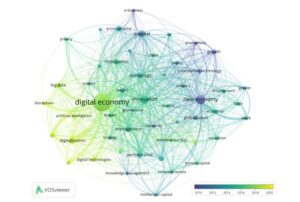
Figure 6: Map of links between keywords in time
Source: Authors’ own computation through VOSviewer
The analysis of the clusters offered by the Vosviewer application highlights the logic of their formation, to consolidate the basic idea of this paper. The overlap of figure no. 5 over figure no. 6 facilitates, for the authors, the following conclusion, which explains the choice of the title of the present article: the clusters presented in figure no. 5 become transparent in figure no. 6, where there are three basic colors – and their nuances – which represent the formation of links in time between keywords, and, at the same time, the period in which a particular keyword/subject came to the attention of academia and research environment. Observing these details, it is at least tempting to analyze the figure above from right to left, following the purple nodes first, then the green/turquoise nodes and finally the yellow/light green ones. This highlights the fact that in association with “digital economy”, “internet economy”, “web economy” and “new economy”, the first keywords addressed in the specialized literature were “growth”, “productivity”, “industry”, “new economy”, “internet” and “e-business”. In the authors view, the first three words identified can represent the motives that formed the basis of the new economy, those of development, productivity growth, rationalization of production factors and increasing the performance of economic industries. As a catalyst, the Internet can encompass the next important group of keywords, along with “e-business” and “ICT”, which can be treated as a bridge to the other concepts identified in the analysis and discussed below. The next transition group is identified by the keywords “competitiveness”, “human capital”, “performance”, “knowledge management”, “information technology”, and “innovation”. This group, in the authors perspective, represents a decisive stage, imperative to be completed, as it defines and outlines innovative concepts, based on which the digital economy is built – such as: information management, human capital management, maintaining competitiveness, technology information and innovation. Subsequently, the group of keywords preceding the digital economy is identified, with which the following are associated: “e-commerce”, “strategy”, “management”, “information”, and “systems”. These representing, except for the concept of “e-commerce”, alignment and convergence towards the digital economy – complex and divergent concept, on which there is no unanimous acceptance regarding its definition. The digital economy is transposed in the contemporary context, according to figure no. 6, to concepts such as “blockchain”, “big data”, “artificial intelligence”, and so on. Thus, both figures above facilitate the understanding of the concept of digital economy from the perspective of the surrounding and preceding elements.
In other studies performed in this field, it is visible that nowadays, digital economy is heading to the direction of Bid Data, Artificial Intelligence, Blockchain and Neural Networks (Konys, 2020).
Conclusions
This article aimed at capturing and analyzing scientific papers published in journals and conferences in the field of digital economy. The search of the WoS Core Collection database resulted in 4,624 scientific writings, which were analyzed in three directions: analysis of papers – targeting information such as country/region in which they were published, institution, authors, research areas, etc.; citation report analysis; and keyword analysis. To perform the three main analyses, the authors used the functions of the WoS platform – Clarivate Analytics, Microsoft Excel and VOSViewer software.
Each section of the analysis in this bibliometric review presents, in an organized form, the data used and the analysis performed. The main conclusions worth mentioning are the following:
- The digital economy is a field/research topic that aroused the interest of researchers before the 2000s;
- The number of articles associated with this topic is constantly increasing during 1979-2019 (see Figure no. 1);
- The directions of the digital economy approach are varied, and starting from 2016, all research areas started dealing with the subject of the digital economy (see Figure no. 2);
- The number of citations of the analyzed articles maintains a sustained upward trend, validating their academic and scientific value and signifying that the writings are increasingly well documented;
- The analysis of the keywords highlights the main segments of interest for the digital economy, from which it was born (“labor productivity”; “competitiveness”; “internet”; “information technology”; “knowledge management”; “ICT”; “technology”; “strategy”; “management”; “e-business”; and “e-commerce”), and where it’s heading (“artificial intelligence”; “big data”; “blockchain”; “IoT”; etc.). This research is limited to authors’ knowledge and data used to compute the bibliometric analysis.
Acknowledgment
This paper was published with financial support from Bucharest University of Economic Studies, during the PhD program.
(adsbygoogle = window.adsbygoogle || []).push({});
References
- Andrés, A. (2009). Measuring Academic Research: How to Undertake a Bibliometric Study. Oxford: Chandos Publishing
- Borner, K. &Polley D.E. (2014). Visual insights. A practical guide to making sense of data. MIT Press. USA
- Bradley, K., (2007) Defining digital sustainability. Library Trends, 56:148–63
- British Computer Society, 2014. The Digital Economy, British Computer Society, London. https://policy.bcs.org/sites/policy.bcs.org/files/digital%20economy%20Final%20version_0.pdf
- Brynjolfsson, E. &Kahin, B. (2000). Understanding the Digital Economy: Data, Tools, and Research. Cambridge: MIT Press.
- Dahlman, C., Mealy, S. &Wermelinger, M., (2016). Harnessing the Digital Economy for Developing Countries, OECD, Paris. Retrieved October 20, 2020 from http://www.oecd- ilibrary.org/docserver/download/4adffb24-en.pdf
- Deloitte, (n.d.) What is Digital Economy? Deloitte, New York, NY. https://www2.deloitte.com/mt/en/pages/technology/articles/mt-what-is-digitaleconomy.html
- EC, 2013. Expert Group on Taxation of the Digital Economy, European Commission, Brussels.http://ec.europa.eu/taxation_customs/sites/taxation/files/resources/documents/taxation/gen _info/good_governance_matters/digital/general_issues.pdf
- van Eck, N. J. and Waltman, L. (2013) ‘{VOSviewer} manual’, Leiden: Univeristeit Leiden, (November). Available at: http://www.vosviewer.com/documentation/Manual_VOSviewer_1.6.1.pdf.
- Manesh, F.M., et al. (2021) ‘Knowledge Management in the Fourth Industrial Revolution: Mapping the Literature and Scoping Future Avenues’, IEEE Transactions on Engineering Management, 68(1), pp. 289–300. doi: 10.1109/TEM.2019.2963489.
- George, G., Merrill, R.K., Schillebeeckx, S.J.D., (2020) Digital Sustainability and Entrepreneurship: How Digital Innovations Are Helping Tackle Climate Change and Sustainable Development. Entrepreneurship Theory and Practice. 104225871989942. https://doi.org/10.1177/1042258719899425
- G20 DETF, 2016. G20 Digital Economy Development and Cooperation Initiative, G20 Digital Economy Task Force. http://www.g20.utoronto.ca/2016/g20-digital-economy-development-and- cooperation.pdf
- Lock, I., Seele, P.,(2017). Theorizing stakeholders of sustainability in the digital age. Sustainability Science;12:235–45. https://doi.org/10.1007/s11625-016-0404-2.
- Konys, A. (2020) ‘How to support digital sustainability assessment? An attempt to knowledge systematization’, Procedia Computer Science, 176, pp. 2297–2311. doi: 10.1016/j.procs.2020.09.288.
- Margherio, L. et al., 1999. The Emerging Digital Economy, Department of Commerce, Washington, DC. http://www.esa.doc.gov/sites/default/files/emergingdig_0.pdf
- OECD, 2013. The Digital Economy, OECD, Paris. http://www.oecd.org/daf/competition/The-Digital- Economy-2012.pdf
- Order of the Government of the Russian Federation adopting the program “Digital economy of the Russian Federation” (2017). Retrieved from: http://government.ru/docs/28653/
- (2017). Digital Economy, Oxford Dictionary, Oxford University Press, Oxford, UK. Retrieved October 22, 2020 from https://en.oxforddictionaries.com/definition/digital_economy
- B. Musgrove, R. Binns, T. Page-Kennedy, M. Thelwall, A method for identifying clusters in sets of interlinking Web spaces, Scientometrics, 58 (2003) 657-672
- United Nations (2017) ‘The « New » Digital Economy and Development: UNCTAD Technical Notes on ICT for Development N˚8’, Unctad, Division on Technology and Logistics Science, Technology and Ict Branch Ict Policy Section, TN/UNCTAD/(1), p. 37.
- Vap Gorp N., Batura O. (2015). Challenges for Competition Policy in a Digitalised Economy (study for the European Parliament. European Union)
- Waltman, L., Van Eck, N.J., & Noyons, E.C.M. (2010). A unified approach to mapping and clustering of bibliometric networks. Journal of Informetrics, 4(4), 629-635. doi:10.1016/j.joi.2010.07.002
- World Bank (2016) Review of the Report on the global development “Digital dividends”. https://dx.doi.org/10.1596/978-1-4648-0671-1.
- WoS (2021). 4624 selected documents – Analyze Results & Citation Reports. Retrieved February 10th, 2021, from www.webofscience.com.
- Wu, D.S., Xie, Y.J., Dai, Q.Z., Li. J.P., (2016). A Systematic overview of operations research/ management science research in Mainland China: Bibliometric analysis of the period 2001-2013, Asia-Pacific Journal of Operational Research, forthcoming
- Yang, L., Wu, M., Cui, L. (2012). Integration of three visualization methods based on co-word analysis, Scientometrics, 90 659-673.













